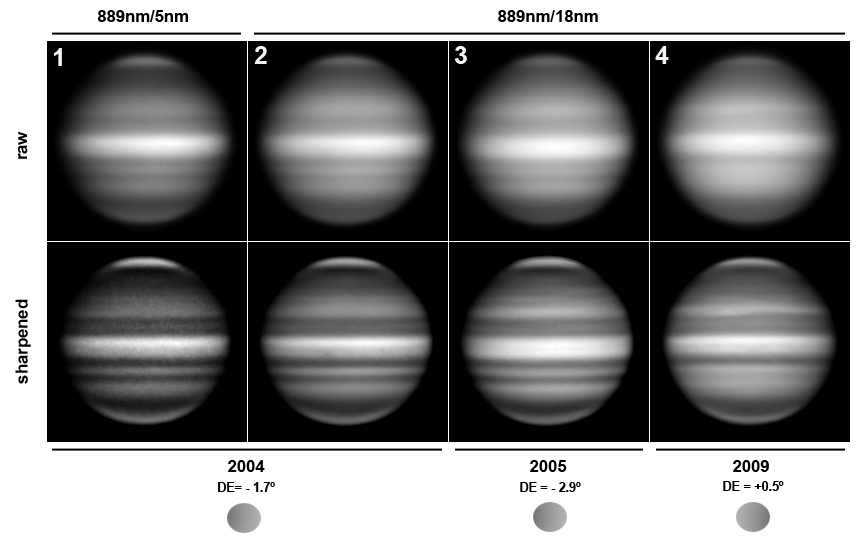
The use of master axi-symetric median frames in Jupiter Methane-Band (889nm) imaging projects
António J. Cidadão
The previous section of this page showed some examples of the usefulness of CH4-band ratio-images (always obtained from calibrated but otherwise unprocessed raws) in Jupiter imaging projects. Another approach for such projects, which overcomes the need of accurate time-based registering but instead enphasizes the latitude-based large-scale planetary albedo, is the use of axi-symetric master median frames.
These are produced from sufficiently long series of perfectly registered and scaled image raws, usually obtained in more than one observation session, and that should present the highest possible diversity of CM values. To compensate for sky transparency within and between sessions, frames should be linearly-stretched (range parameter black=sky, white=the bightest pixel in the planetary image, not on eventual sattelites) to 16-bits.
When this long series of raw frames is subjected to a median-stack, all small-scale features whose albedo deviates from the characteristic planetary latitude-based albedo, at a given apparition, or with a given CH4-filter, are washed away.
The large series of one-minute CH4-band integrations that my setup allows (using only one CH4-filter or automatically alternating the 889nm/5nm and /18nm filters) are specially adequate for this purpose, as well as to produce smooth albeit classical CH4-band time-lapse animations.
In the example below, axi-symetric median master frames were obtained with the 889nm/5nm filter ("1", 29 frames) or with the 889nm/18nm filter ("2", 116 frames; "3", 339 frames; "4", 188 frames). They were also obtained in different apparirions ("1" and "2", on Jan-Feb 2004; "3", on Feb 2005; "4", on Aug-Sep 2009). Other factors also varied between apparitions, namely planetary-tilt (the Declination of Earth, "DE", is depicted), and if images were obtained before (2004 and 2005) or after opposition (2009; the more pronounced limb darkening is shown in the small disk drawings). Although ratio-images are always produced from raws, sharpened versions of the axi-symetric medians are presented in the bottom row.
This pannel of master median-frames can be used to probe for filter-specific albedo variations on images obtained at the same time-period (e.g. 5nm- and 18nm-filters during the 2004 apparition), which essentially should confirm, albeit at a global scale, the type of data already mentioned in the previous section of this page.
On the other hand, axi-symetric medians can also be applied to check for changes on planetary albedo that the same filter (e.g. the 18nm-filter) eventually reveals in different apparitions (e.g. between 2005 and 2009). Particular attention must be paid to compensate for different "DE" values, otherwise the ratio-images will most certainly give riso to false patterns.

The "blink" animation below (left- and mid-images are, respectively, raw-frames and similarly sharpened-frames obtained with both CH4-filters; right frame alternates a sharpened-image and the "5nm : 18nm" ratio-image) clearly shows the already mentioned differential effect of the two methane filters. This time, however, GRS, wos, or NEBs projection differential appearance between filters is washed away, as it should be since these are axi-symetric medians. In contrast, the darker appearance of the both EBs and also of the, at the time, very conspicuous NTB is clearly shown on frames and ratio-image. Please refer to the first section of this page for an interpretation of the behavior of "cyclonic" belts.

The animation below (raw frames at the left, similarly sharpened versions at the right) shows planetary tilt ("DE" is specified), and albedo variations with time (apparition year is shown). Tilt differences are obvious, but also notice, for instance, how the NTB becomes less noticeable in the methane-band in 2009. Also, the EZn has a lower albedo than the EZs in 2004 and 2009, but not in 2005.
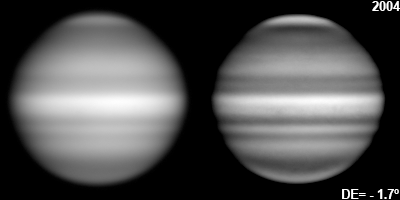
The above master median frames were then used to produce the ratio images shown in the following pannel (at the middle-column; right and left columns show CM-slices of raws and sharpened variants of median-frames, respectively, with vertical shifting to compensate for differential planetary tilt.
Notice how the already mentioned EZn/EZs behavior in different years, as well as that of NTB, are patent in ratio images.
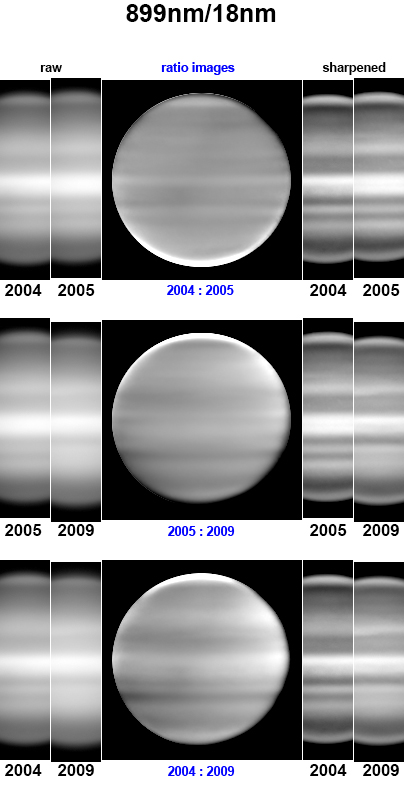
Axi-symetric median frames like that presented below (it is the 889nm/18nm 2005 frame mentioned above, but now presented in its original pixel sampling) also have, in my opinion, a great value to calibrate conventional CH4-band frames, or even time-lapse animations as this one (containing a sequence of calibrated raws obtained with the 889nm/18nm filter, obviously in 2005).
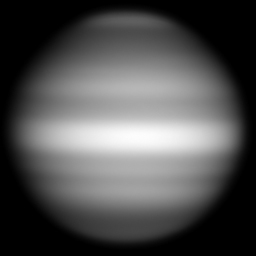
In short, when a given CH4-band image (or frame in a time-lapse) is divided by a matching axi-symetric median frame, only remain in the resulting ratio-image (middle column in the pannel below) subtle albedo deviations from the global latitude albedo-pattern prevailing at that apparition (of course marked albedo deviations, as the GRS, wos, or satellites, are also enhanced). This often highlights diffuse patches/regions with higher- or lower-than-median jovian albedo that, in most cases, are missed in raws (left column) or even in sharpened frames (right column). Besides, these diffuse patches appear to cross belt-zone boundaries.
A follow-up of the behavior of such diffuse patches with time, and to probe for possible correlations with the albedo features seen with filters other than CH4, is for me particularly exciting and a personal project for the coming years!
Please click here to activate a time-lapse of ratio images where the diffuse patches and other more easily recognized features are seen rotating with the planet. Ganymede in transit is a bonus. Alternatively, click here to see all three image variants rotating simultaneously and in register.
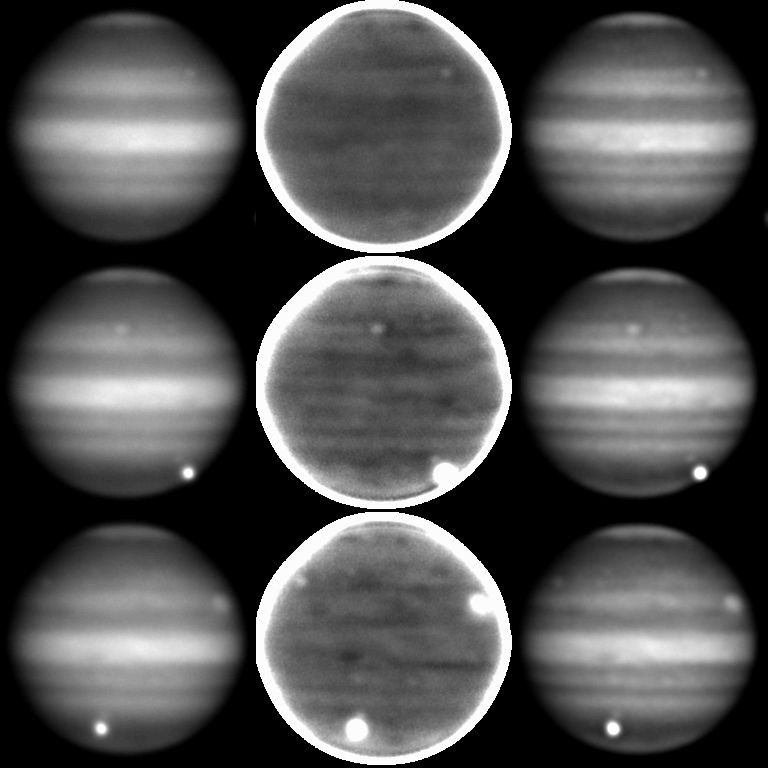
Go to next section of this page.